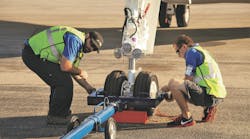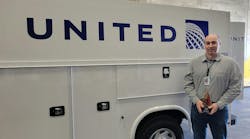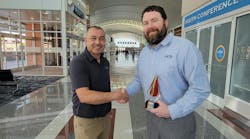Information Technology
By Monica L. Rausch Associate Editor
March 1999
One Step Closer To Free Flight
Although the dream of "free flight" in the National Airspace System (NAS)
may seem far off, some air traffic controllers are lucky enough to be
in on its early stages of development.
Software developed by the NASA Ames Research Center, and now in place at Dallas/Fort Worth TRACON and Fort Worth Center, is saving an estimated $800 million a year in flight delays, according to its producers. This software, called the Center TRACON Automation System (CTAS), incorporates two tools: Traffic Management Advisor and the Final Approach Spacing Tool.
The Advisor helps traffic managers establish a flow rate of air traffic that closely matches the capacity of an airport, while the Final Approach Spacing Tool gives suggested landing sequences and runway assignments to minimize delays and increase landing rates by 10 percent during rush hour.
The software runs in a Windows environment, according to its creators, and is built to allow additional tools in the future, always something to look for in any software. One of these additional tools which is currently in development is the Descent Advisor, which improves fuel efficiency during the descent of large aircraft into an airport.
The tools are also designed to be "human centered," which according to Michelle Eshow, CTAS software development group leader at Ames, means that, "We try to provide automation assistance to controllers in a way that makes it easy for them to see what the software is doing and easy for them to change the software decisions if they don't agree with them. They can tell the software, ’I don't like that decision. Do this instead.'"
Keeping the user in mind is obviously key in developing user-friendly software and is even more important when that software is used by those directing traffic in the NAS. This software allows controllers to work with it instead of giving the software too much control.
NASA Ames doesn't typically develop software for use by other government agencies since it's busy doing research for Mars missions, wind-tunnel testing, and other aerospace studies. In fact, this software grew out of the center's internal research interests, says Eshow. Those at NASA were able to finger a need in the ATC system and fill it. "Now it's considered a very good thing, but when we started it there wasn't really a strong connection there," says Eshow of the relationship between Ames research and FAA's information technology needs.
Earlier versions of the software are also in daily use at Denver, Los Angeles, Hartsfield — Atlanta, and Miami International Airports and plans include installing the software at 22 major airports and 15 enroute centers.
FAA's Free Flight project involves establishing a new system of air traffic management that uses new technologies to increase the safety, capacity, and efficiency of air traffic operations. According to a report issued by the U.S. General Accounting Office in September, 1998, FAA has accomplished a few initiatives under the program, but has many challenges ahead; one includes listening to and coordinating FAA efforts with those whom GAO calls the system's "stakeholders."
However, it's heartening to see NASA taking an initiative to contribute to the project and developing a flexible software that can be built upon — and also has the user in mind. If you have topics on information technology that you think should be addressed in this column, contact Monica Rausch at (920) 563-1648 or e-mail to [email protected]




